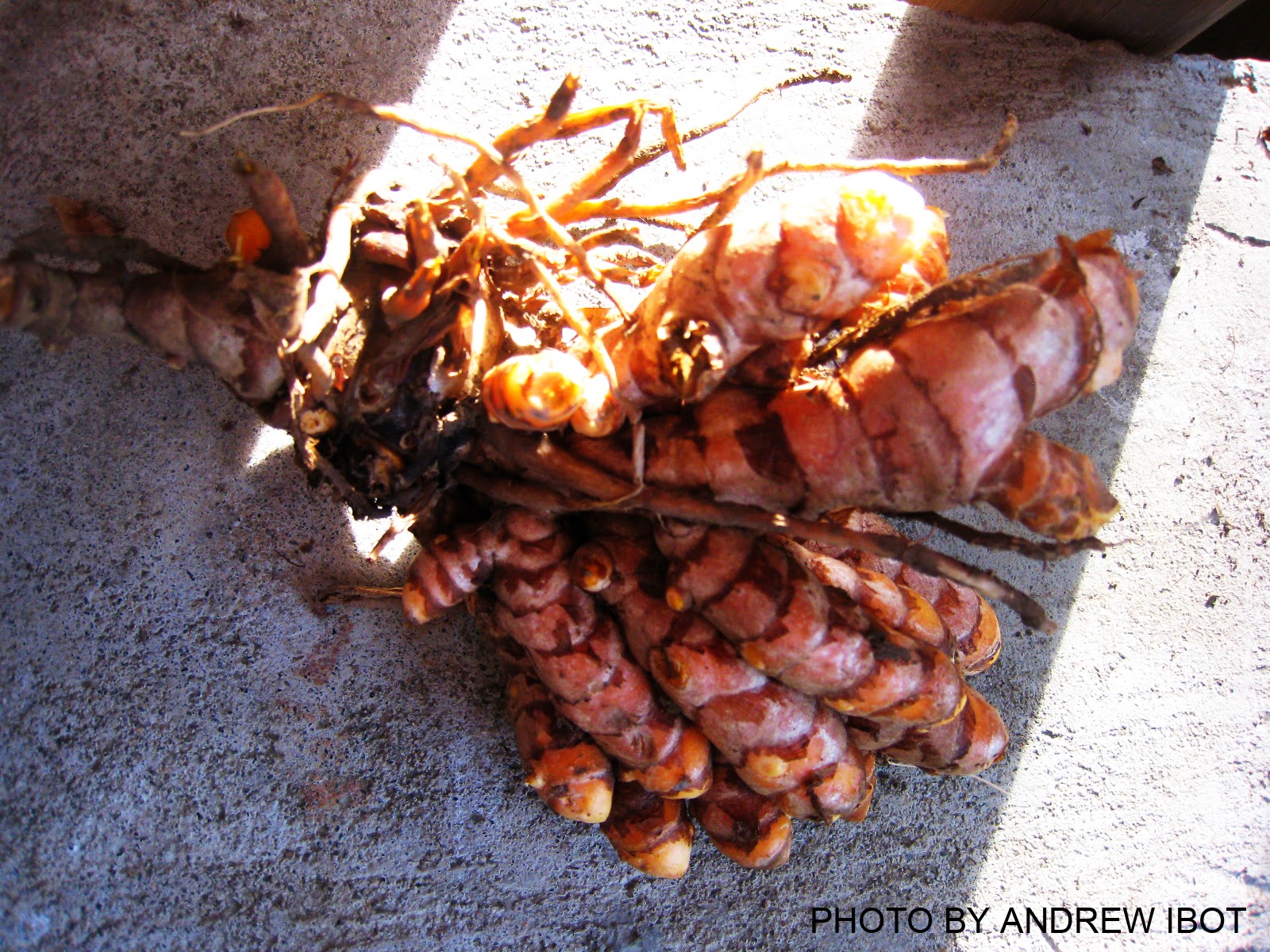 Dilaw is a leafy plant, 1 to 1.5 meters tall, with 5 to 6 leaves. Rhizomes are bright yellow inside, thick and cylindric. Leaf blade is green, oblong, 30 to 45 centimeters long and 10 to 20 centimeters wide. Petiole is as long as the blade. Peduncle is 15 centimeters or more in length, borne within the tuft of leaves. Spikes are 10 to 20 centimeters in length and about 5 centimeters in diameter. Floral bracts are pale green, ovate, 3 to 4 centimeters long, the comabracts tinged with pink. Flowers are pale yellow, as long as the bracts. Fruits are capsules.
Dilaw is a leafy plant, 1 to 1.5 meters tall, with 5 to 6 leaves. Rhizomes are bright yellow inside, thick and cylindric. Leaf blade is green, oblong, 30 to 45 centimeters long and 10 to 20 centimeters wide. Petiole is as long as the blade. Peduncle is 15 centimeters or more in length, borne within the tuft of leaves. Spikes are 10 to 20 centimeters in length and about 5 centimeters in diameter. Floral bracts are pale green, ovate, 3 to 4 centimeters long, the comabracts tinged with pink. Flowers are pale yellow, as long as the bracts. Fruits are capsules.Distribution
- Widely distributed in the Philippines in and about towns, sometimes in open waste places and sometimes planted.
- Native of India.
- Now pantropic.
- Rhizome, leaves.
- Collect the whole year round.
- Rinse, removes roots, section into pieces, steam and sun-dry.
- Active constituents are flavonoid curcumin (diferuloylmethane) and various volatile oils, including tumerone, atlantone, and zingiberone.
- Volatile oil, 3-5% - tumerol (alcohol), d-alpha phellandrene, carvone, camphor, curcumone; fat, 3%; starch, 30%; resin; curcumin (pigment).
- Yields three curcuminoids - curcumin (diferuloylmethane, the primary constituent, responsible for the vibrant yellow color), demothoxycurcumin and bisdemethoxycurcumin - plus volatile oils (tumerone, atiantone and zingiberone), sugars, proteins, and resins.
- Yellow orange color comes from yellow pigment in the rhizomes called curcumin.
- A good source of phosphorus and iron; but hardly a fair source of calcium.
- Pungent and bitter tasting, warming, carminative.
- In Chinese medicine, believed to Improve Ch'i circulation.
- Studies have demonstrated various therapeutics effects: antioxidant, antiinflammatory, cholesterol-lowering, antibacterial, antifungal, antiviral, immunomodulatory, hepatoprotective, and anticarcinogenic activity.
- Antiinflammatory activity has been compared to topical hydrocortisone.
- Antiseptic, anti -contusion, antibacterial, antifungal.
- Aromatic, stimulant, tonic, cordial, emmenagogue and astringent.
- Rhizomes are used medicinally, as powder, paste, ointment, oil, lotion, inhalant, and confection.
Culinary / Nutritional
- Condiment, ingredient of curry powder, and coloring for food.In dried or powdered form, used like ginger.
- Good source of phosphorus and iron, a fair source of calcium.
- Rhizomes commonly sold in Manila markets. dried
- In Java, flour is made from the plant is the same way as cassava and arrowroot, used for all kinds of dainties.
- Decoction of rhizome, as tea, used for fevers, dysentery, abdominal pain, flatulence, abdominal spasm, arthritis.
- In the Philippines, rhizomes with coconut oil used as stomachic and vulnerary.
- Internally, juice of fresh rhizome used as anthelmintic.
- Used for menstrual irregularities, contusions and associated painful swelling.
- Antiseptic for wounds: Crush rhizome and apply to wounds.
- Externally, rhizomes are applied to insect bites, ringworm, bleeding.
- A 1:20 decoction used in catarrhal and purulent ophthalmia.
- In India, used as antiseptic for cuts. Used for leprosy, liver problems, swelling, insect bites, wounds, whooping cough, pimples. Sweetened milk boiled with tumeric is popular as a remedy for colds and cough. Juice of fresh rhizome used externally on wounds, bruises and leech-bites.
- Tumeric paste mixed with a little lime and saltpeter is applied hot to sprains and bruises.
- For smallpox and chicken pox, coating of tumeric powder or thin paste applied externally to facilitate scabbing.
- Paste made from flowers used for ringworm and other parasitic skin infections.
- Ointment used in neuralgia and rheumatism.
- Rhizomes with coconut oil used as stomachic and vulnerary.
- Rhizome used for intermittent fevers, flatulence,, dyspepsia.
- In Ayurveda, use as stomach and liver tonic and blood purifier.
- Malays use it as carminative and for dispelling flatulence.
- In China used for colic, amenorrhea, congestions.
- Fumes of burning turmeric used as inhalation in catarrh and severe head colds.
- For flatulence in children, used with garlic or onions.
- Used as carminative and antispasmodic, and in diarrhea and dysentery.
Others
- Dye: Tumeric is one of the best known of material dyes, used for dyeing silk, wool and cotton. Rhizomes used for dyeing mats in the Philippines.
- Cosmetic: In Sudan, rhizome used as cosmetic.
- Improves Qi (chi) circulation. Chi is the basis of traditional Eastern medicine. In chinese parlance, chi means 'spirit.' In new-age speak, good health is synonymous with free-flowing energy through meridian pathways. A blocked Qi flow is associated with disease or ill-health.
- Approved by German health authorities for the treatment of dyspeptic complaints.
- Recent uses and preparation
- Ointment: Wash the unpeeled ginger. Chop the rhizomes to fill half a glass of water. Sauté with one glass of coconut oil on low heat for five minutes. Place in a clean bottle and label.
- Antiseptic for wounds: Extract juice of the fresh rhizome and apply directly on the wound or swelling.
- Gas pain in adults: Decoction from thumb-sized rhizome in a glass of water reduced to half.


No comments:
Post a Comment